INTRODUCTION
Scientific investigations at the prehistoric site of Tell Kosak Shamali, the Upper Euphrates, were conducted by the University of Tokyo team Between 1994 and 1997, as part of salvage archaeological operations prior to construction of the Tishreen dam (Directors: Prof. Toshio Matsutani; Dr. Yoshihiro Nishiaki). The excavation of two areas revealed stratified settlements of the Neolithic to the Middle Uruk periods, dating from the 7th to the 4th milennium BC. The most important discovery was a series of pottery workshops of the Ubaid and Post-Ubaid periods. The detailed analysis of the workshops demonstrated the increasing social and economic complexity in these periods, which eventually led to the emergence of urban society in North Syria.
<Participants> *Director *Vice-director
| 1994:1st excavation | Toshio Matsutani*, Yoshihiro Nishiaki**, Manabu Furuyama, Tatsundo Koizumi, Masato Kurabayashi, Takashi Tateno, and Marie Le Mière |
| 1995:2nd excavation | Toshio Matsutani*, Yoshihiro Nishiaki**, Manabu Furuyama, Tatsundo Koizumi, Hiroshi Kurosawa, Marie Le Mière, Takashi Oguchi, Akiyo Maeda, Hiroshi Sudo, Ken Goto, and Chizu Kanenaga |
| 1996:3rd excavation | Toshio Matsutani*, Yoshihiro Nishiaki**, Manabu Furuyama, Tatsundo Koizumi, Hiroshi Kurosawa, Marie Le Mière, Masayuki Akahori, Takashi Oguchi, Masatoshi Tao, Hiroshi Sudo, Takahiro Odaka, Tae makita, and Ryuji Shikaku |
| 1997:4th excavation | Yoshihiro Nishiaki*, Tatsundo Koizumi, Marie Le Mière, Masatoshi Tao, Hiroshi Sudo, Seiji Kadowaki, Masashi Abe, Hiroyuki Tano, Kosuke Yamagishi, and Toshiaki Yanaida |
| 1998: Indoor work | Yoshihiro Nishiaki*, Tatsundo Koizumi, Marie Le Mière, Hiroshi Sudo, Shogo Kume, Toshiaki Yanaida, and Masatsugu Nokubo |
| 1999: Indoor work | Yoshihiro Nishiaki*, Tatsundo Koizumi, Hiroshi Sudo, Seiji Kadowaki, Masashi Abe, and Hiroyuki Tano |
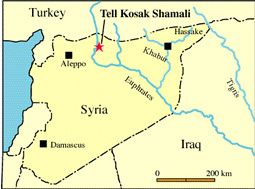
Fig.1a, b The location
of Tell Kosak Shamali.
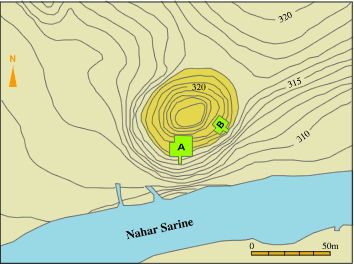
Fig.2 The excavation area of Tell Kosak Shamali.
Table
1 Chronological table of Tell Kosak Shamali Sequence.
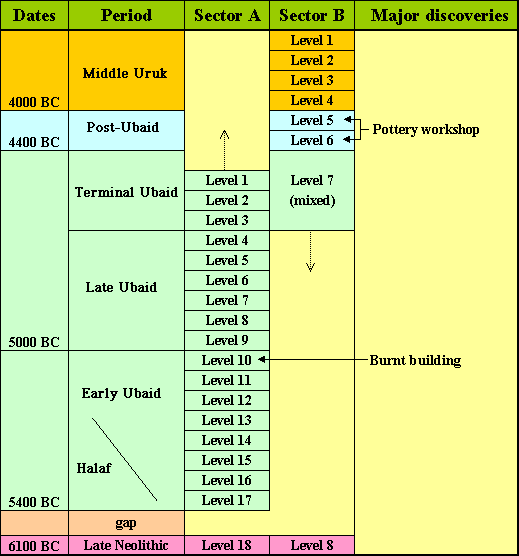
THE UBAID LIFE
The prehistoric people of Tell Kosak Shamali enjoyed its strategic geographic position: it is on a terrace of the Euphrates, cut by the Nahar Sarine, at the edge of the flood plain (Fig.3). In such a location, resourses from different geoecological zones would have been readily available. In addition, the deep valley of the Nahar Sarine must have provided an excellent crossing point of the Euphrates, which even today makes the area important.
The main economy of the Ubaid inhabtants was based on farming. Barley and two species of wheat (emmer and einkorn) were cultivated in the large flood plain as well as in the hilly hinterland. Stock breeding of sheep and goat also made up an important part of daily life. They were mainly killed for meat when young, but notably after the late Ubaid period some females were kept for secondary products, probably milk. A small number of pigs and cattle were also raised. These domesticated food resourses were occasionally supplemented by wild animals including gazelles, water birds and fish.
The tool kits of the Ubaid people consisted of a pottery with fine painted decoration, harvesting and processing tools of grain, wood working axes, spindle whorls, awls and spatulas, and stamp seals for goods control. these tools were mostly made of locally available raw materials. the use of exotic materials, like obsidian from Anatolia, was relatively rare.


Fig.3 (left)Distant
view of Tell Kosak Shamali from the southeast.
The Nahar Sarine,
presently dried up, runs in front from the right.
Fig.4 (right) Tell
Kosak Shamali seen from the south
THE BURNT BUILDINGS OF THE UBAID PERIOD
Level 10 of Sector A produced a large burnt building consisting of at least ten spatial units (Fig.5). Because of the fire, the room floors were exceptionally well-preserved, on which numerous ceramics, stane tools and other objects were discovered in primary contexts.
Remains from the floor indicate this building complex to have been a pottery production workshop. rooms 10A01 and 10A03, which contained over 150 and 20 complete pottery vessels respectively, were mainly used for storage of pottery. Room 10A01 was probably used for pottery production as well, as indicated by a kiln and potter's tools discovered in it. Rooms 10A02 and 10A05, which yiekded numerous pottery production tools such as ceramic scrapers and stone palettes, were perhaps manufacturing rooms. The other rooms appear to have been grain strage.
Organic materials were recovered from the burnt building in an exellent collection. an archaeobotanical analysis of the grain storage shows that wheat and barley were stored separately in different rooms. the wheat included two-seeded einkorn, a species locally domesticated on the Upper Euphrates. The charcoal samples derived from building materials consisted of taxa typically encountered in the gallery forest of the Euphrates. Poplar, willow and alder were used for roof beams while tamarisk was used to cover the spaces between the beams.
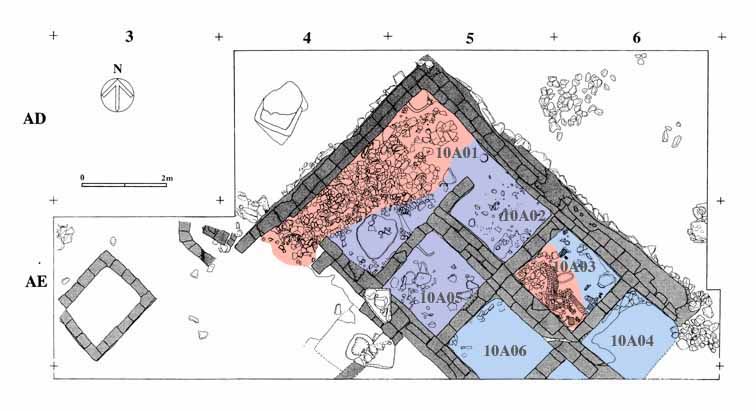
Fig.5 Suggested
room functions for the burnt buildin
[Legend] ![]() Pottery storage
Pottery storage ![]() Pottery production
Pottery production
![]() Grain storage
Grain storage


Fig.6 (left)
The burnt building of Level 10 of Sector A (Ubaid).
Fig.7 (right) Floor
remains from Room 10A02.
Note the ceramic scraper and a horn for pottery manufacturing.

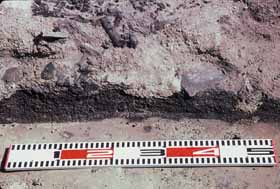
Fig.8 (left) Wood
remains from Room 10A03. The large beam, poplar, once supported the
roof.
Fig.9 (right) Wheat grain discovered from Room 10A06 below the collapsed
roof remains.
POTTERY PRODUCTION OF THE UBAID PERIOD
Clay for pottery was obtained from banks of the Nahar Sarine and the Euphrates. It was then shaped into vessels on a slow turning table. Surfaces of the vessels were smoothed with the use of stone polishers made on river pebbles, and possibly gazelle horns as well. Crescent-shaped ceramic scpapers were also used for surface treatment. The main decoration method was painting. Natural crops of hematite and magnese, processed with grinding stones and palettes, were used as pigments. The painted motifs were mostly geometric, but animals and birds were also depicted. Pottery was fired in horse-shoe shaped kilns, and the vessels were pilled in storage rooms for later distribution.
Pottery from the workshops often contained pairs or groups of pottery that display highly similar workmanship in size, decoration and manufacturing technique. It suggests they were manufactured by a limited number of individuals.
Potter's workshops were discovered from many levels of the Ubaid period. One of the common features is that they overlapped traces of domestic activities in the same building complexes, such as ovens, infant burials and grain storage. this undifferentiated use of similar structures for different purposes may characterize the use of space in the Ubaid period, which is in clear contrast with that in later periods.


Fig.10 (left) Pottery
from the burnt building was all discovered badly crushed.
Fig.11 (right) The
broken sherds were then refitted.
POTTERY PRODUCTION OF THE POST-UBAID PERIOD
Levels 6 and 5of Sector B represent two edisodes of the use of the same building complex, comnsisting of workshop structures for pottery production and firing. Two large kilns, standing over 1.5m high from the room floor, were the remarkable features. They allowed a mass production of pottery. To the south there was a pottery manufacturing room in which a circular bin for clay preparation was installed. The pottery was dried in an area to the east, and then brought in the kiln through a passage paved with mudbricks.
The highly sophisticated workshops, located far from the domestic quarter, suggest the presence of specialized potters and more complex patterns of pottery production and consumption in the Post-Ubaid period.
Pottery of the post-Ubaid period no longer included many painted vessels as in the Ubaid period, but most of them were simple plain wares. Firing was made with a higher temperature using the developed kilns. Pottery production tools also showed changes from the Ubaid period. Ring-shaped scrapers joined in the tool inventory, and stone palettes for pigment preparation, very common in the Ubaid period, virtually disappeared.
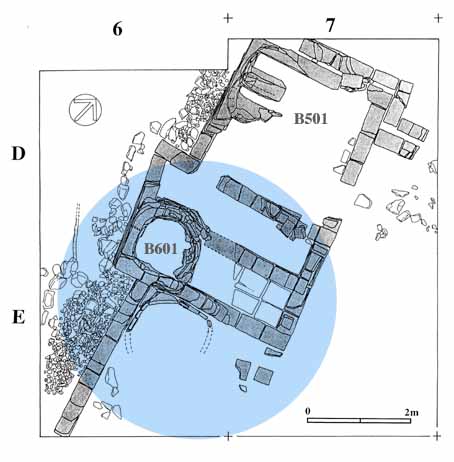
Fig.12 Suggested
room functions for the workshop


Fig.13 (left) The
pottery workshop of Levels 6 and 5 of Sector B (Post-Ubaid)
Fig.14 (right) Pottery
kiln of B601 seen from the east.
The opening for
ash removal was closed when discovered.
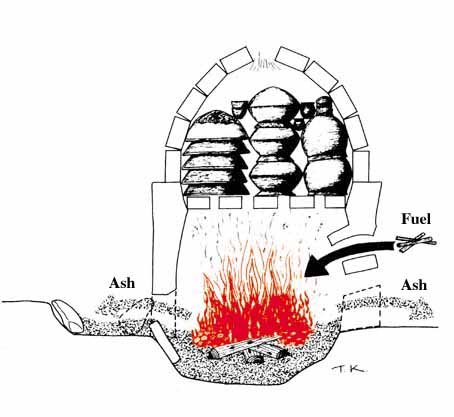
Fig.15 Reconstruction
of the use of Pottery kiln B601.
 FURTHER
READING
FURTHER
READING
This
website is designed by Yasuhisa
Kondo and supervised by Dr. Nishiaki's Laboratory, the University Museum,
University of Tokyo.
Mailto: umdawa@um.u-tokyo.ac.jp
Copyright
© 2002- Laboratory
for the Prehistoric Archaeology of Western Asia, the University Museum,
University of Tokyo.
All rights Reserved.
Reproducing
the contents of this website without our permission is forbidden in any
case.